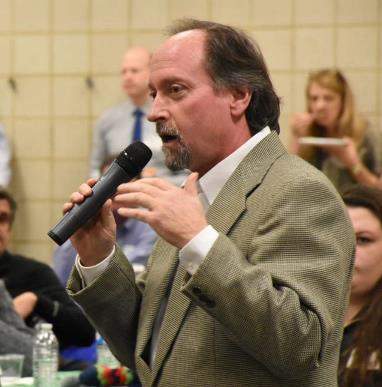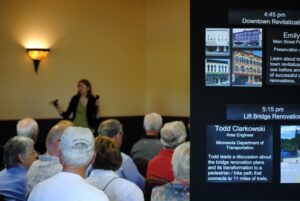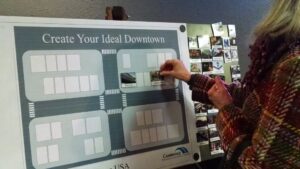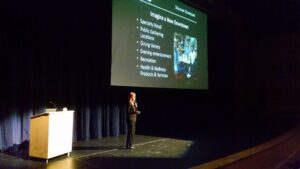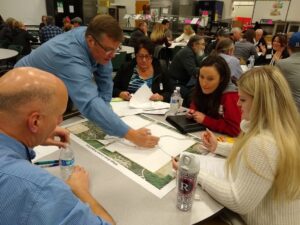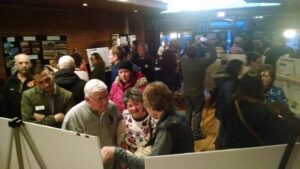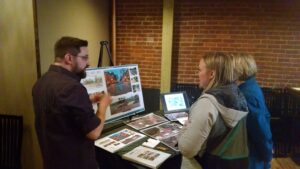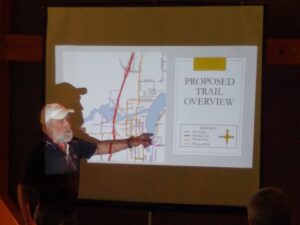This Guest Article for REVITALIZATION is by Todd Streeter.
There are any number of methods and organizations devoted to helping revitalize communities that produce a wide variety of results.
I’d like to share with you another method developed over several years as president/executive director of the Greater Stillwater Chamber of Commerce during a downtown revitalization initiative.
The method proved so effective it’s being used by municipalities and government agencies ranging from downtown revitalization and master planned redevelopment projects to comprehensive plans for communities large and small.
The method even won the 2019 Wisconsin American Planners Association Planning Excellence Award for Innovation.
The award jury commented the method: “… shows the level of strategic engagement by focusing on implementation in small groups. This approach can be effective with great buy-in. This intensive work should receive an award due to the level of realistic strategic goal setting in this action groups.”
What Makes this Method Unique?

New Richmond Downtown Revitalization subcommittee chair walks through their committee’s project presentation.
First – It’s a true bottom up community-driven process not led by professional planners or municipal staff but by the citizens themselves.
When staff and planning experts step off to the side and turn the creative process over to the community, unexpected outcomes begin to emerge resulting in not only increased community participation, but wide spread buy-in, sense of ownership, and even local funding potential.
With traditional engagement methods, brainstorming sessions are typically held with interested community participants lasting just several hours. Then, municipal staff and planners collaborate to develop concepts that are eventually unveiled for additional community input through modestly attended open houses.
This passive engagement method relies on the work created by others. Unfortunately this approach doesn’t increase community participation, buy-in, sense of ownership, or generate local funding interest.
“This has been a real eye-opening experience. We transferred ownership of the process to the committee and they all stepped up and delivered many very thoughtful and innovative ideas we hadn’t considered before,” said Beth Thompson, Community Development Director, City of New Richmond, WI.
Second – When an objective third party not steeped in planning practices facilities the process, community volunteers assimilate with the project tasks at a level that’s comfortable for them as they take the lead in researching ideas they are responsible for developing.
And why shouldn’t citizens lead in creating great ideas for their own community – they live, work and play there – who is more knowledgeable and vested in the future of their community? Is it common for municipal leaders, staff and planning firms to let the community actual lead the process? No not really – hence the award for innovation.
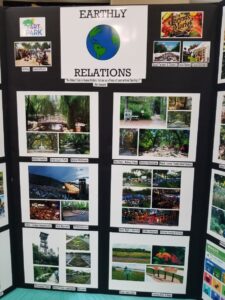 Third – Another intriguing aspect of the process is to watch friendly competition set in as each subcommittee presents updates on their research activities and concept developments.
Third – Another intriguing aspect of the process is to watch friendly competition set in as each subcommittee presents updates on their research activities and concept developments.
For example, without any prompting on my part, one subcommittee showed up at the next meeting with complete storyboards showing images conveying the ideas and vision under development. The following meeting, three more committees, not wanting to be outdone, arrived with their own storyboards in tow. This organic competition is not just healthy, it spurs each subcommittee to rise to yet another level of commitment not expected by anyone at the start of the project.
Finally – This process allows the community to switch places with municipal staff. Does staff ever wish their community had to deal with the issues and challenges they face everyday?
As a former mayor I would say the answer is yes, but they’re never given the chance. When they do switch places, the community begins to learn that solving problems and issues they complain about is not easy. Faced with the same realizations and limitations staff encounter, citizens begin to understand that finding solutions are not as simple as complaining.
Over many months as committed volunteers, local citizens working together start to see the potential of their combined ideas and research from other communities.
Their dedication to the process and pride of their very own work is what creates wide spread buy-in. And where does the investment of time and effort lead? It cultivates a deep sense of ownership and strong desire to see their recommendations become reality which in turn fosters their continued involvement and local funding support.
“I really like what you’re bringing as new to the ‘civic engagement experience’. I have experienced this success first hand and believe you’re on the right track! As a veteran planner, policy advocate, and community leader with the Minnesota Chapter of the American Planning Association and Minnesota Design Team in Minnesota; I believe your new approach can be a meaningful game changer on how to get things done,” says Andrew Mack, AICP, Principal Planner, Rural & Urban Planning Services.
The Genesis of the Working Committee™ Method
When I convened the Downtown Revitalization Committee (DRC) in Stillwater, Minnesota, I knew the challenges were many. As chamber director, I knew everything was not going smoothly in its historic downtown along the St. Croix River.
Not everyone was getting along; a faction here and a faction there; lack of trust between downtown and city officials; and constant complaining with no real sense of direction or potential solutions. Does this sound familiar? Unfortunately, it’s all too common.
Growing tired of hearing the same complaints ranging from dead winters to a downtown overrun by events and tourists, it was time to bring the city, county, downtown businesses and property owners together to find ways to collaborate as one group moving downtown forward.

Stillwater DRC committee listens to guest speaker to learn more about essential planning principles.
I convened the first DRC meeting with 45 stakeholders in attendance. They asked why they were there. I said it was time to work together to plan downtown’s future. Someone perked up and said they did this before.
I said “What did you do?” She said, “Six of us got together and created a notebook.” I asked, “What did you do with the notebook?” Her response: “Nothing.” “Why?” I asked. “No one wanted to do the work,” she replied. “Well, we won’t be creating notebooks,” I said. I continued … “I know that the other strategy is to go up to city hall and pound your fist on the table while saying “make my downtown better.” “How’s that working for you?” They all laughed. I said, “Well, you have no choice. You have to do the work.”
Thus was the beginning of the Working Committee™ community engagement approach.
For two and a half years of meeting once a month while taking summers off, the DRC worked side by side on any one of the six subcommittees focusing on major elements of downtown. After the subcommittees researched their ideas and concepts, they presented their recommendations to the city council in a formal presentation.
Not only were city staff and council astonished by downtown’s ability to come together and work as one, the entire relationships among city, county and downtown were completely reestablished with a common vision of the future.
No more complaining to the city. No more silos. No more distrust or unproductive attitudes. Not only did the relationships improve, but calls were coming into the chamber from residents inquiring how they could support and even fund some the of the DRC’s final recommendations.
In fact, the DRC received more than $100,000 in funding and in-kind pro bono architectural planning work from four local architects.
The new bottom up engagement concept produced better than expected results for Stillwater, but would it work in other cities under different circumstances? It was time to leave the chamber to find out.
“The ideas, opportunities and vision they developed has been of tremendous value to our on-going community development efforts. Having watched Todd’s work and seen the results, I believe a committed focus to business needs, concerns and desires should be included in the public engagement process for any community improvement project or comprehensive plan update,” says Bill Turnblad, Community Development Director, City of Stillwater, MN.
Will the Method Work for Other Municipalities?
My first client as an independent consultant was the City of Cambridge, Minnesota. After doing initial pro bono work as a MN Design Team volunteer, I circled back with their city administrator and explained how I used my engagement method for Stillwater’s downtown revitalization and she suggested using it to reenergize their downtown revitalization efforts as well.
The city’s Downtown Task Force was low on energy and participation and needed new inspiration. I kicked off the 6-month project with more than 40 committee volunteers.
After five months of bi-monthly meetings, the Discover Downtown Cambridge committee with its six subcommittees created approximately 50 recommendations to revitalize downtown.
Per the process, they prepared for their open house with presentations, storyboards and maps. The room was overflowing with residents anxious to see the committee’s work and thoughtful vision for downtown.
Several weeks after the open house the committee was prepared to present to the community and city officials in the high school’s auditorium. The response from the audience was tremendous. City staff comments were equally as gracious ….
“What I like about the new approach is that the city officials step back and let the community dream away without consideration of what staff may think. It will truly be liberating for the community and the city,” said Lynda Woulfe, City Administrator, City of Cambridge, MN.
The next step of the process was the formation of an Executive Committee consisting of new members and previous Discover Downtown Cambridge subcommittee chairs.
In this phase, the new committee reviews the previous committee’s extensive list of recommendations and begins the process of defining short, medium and long-terms goals reflecting each recommendation’s level of complexity and potential funding requirements.
A year after their community presentation, Discover Downtown Cambridge made significant progress towards implementing many of their recommendations.
“I’ve been watching the process go from individuals interested in improving downtown to a cohesive, committed group meeting every week to develop fresh ideas the city and ongoing community support can study further for possible implementation in the future,” says Stan Gustafson, Economic Development Director, City of Cambridge, MN.
View Committee Recommendations: Cambridge Revitalization Recommendations
Redevelopment Project Attracts Large Citizen Participation
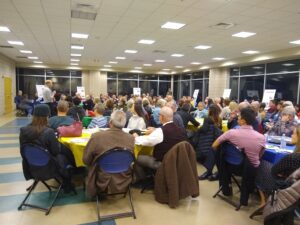
Nathan Thiel, village administrator, welcomes the 150 attendees at the Village Green Center Downtown Development Kickoff event.
Shortly after presenting my Working Committee™ engagement process at the League of Wisconsin Municipalities annual conference I received a call from the Village of Pleasant Prairie, Wisconsin.
The administrator attended the presentation and wanted to use the process for a 180 acre master planned mixed use redevelopment project.
We launched the project with the typical project kickoff presentation and staff and board members were delighted when 150 people attended to learn about the project and how they could participate in shaping their community’s future.
By evening’s end we had more than 70 citizen volunteers signed up to participate on the 6-month project.
I was equally delighted yet somewhat overwhelmed by the prospects of having so many people populating the committee and subcommittees.
Due to the shear size of this project I decided to create 8 subcommittees focusing on major elements and the complex nature of the project.
This project was also a bit more challenging in that Discover Downtown Cambridge focused on existing buildings, open spaces and business mix.
This project, Designing Downtown Pleasant Prairie, was mostly a blank piece of paper due to much of the project’s unimproved property.
As a community situated on the shore of Lake Michigan and the Illinois border, it was generally a bedroom community sharing large contemporary commercial zones lined with national brands along the city border with Kenosha, yet having no historical downtown district or identity-serving destination Pleasant Prairie could call its own.
Designing Downtown Pleasant Prairie committees:
- Epicenter on the Prairie (Civic Facilities & Amenities)
- Village Marketplace (Commercial District)
- A Place for Everyone (Housing Options)
- The Leisurely Life (Parks, Trails, Open Spaces & Recreation)
- Arrive As You Wish (Vehicle & Personal Modal Infrastructure)
- Pleasantville (Aesthetics, Branding & Themes)
- Earthly Relations (Sustainable Development)
- The Village Voice (Marketing & Promotion)
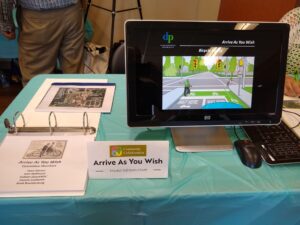
Arrive As You Wish subcommittee open house exhibit table shows presentation, maps and handout materials for attendees to take home.
As with the other downtown revitalization projects, Designing Downtown Pleasant Prairie hosted their community open house with more than 300 attending to view their presentations, storyboards, concept layouts and handouts.
Several weeks later the community hosted another 300 plus attendees for their final community presentation.
Village staff and board members were ecstatic about the committee’s quality of work and well-conceptualized ideas and recommendations.
“It is incredible the way the Community Collaboration method engaged and activated the interest of our community. Citizens were truly empowered to participate and develop a vision for the Village Green Center. I am amazed the creativity and enthusiasm it sparked, and grateful for the relationships the process created,” said Nathan Thiel, Village Administrator, Village of Pleasant Prairie, WI.
Watch Presentation Video: Pleasant Prairie ‘Pleasantville’ Subcommittee Presentation (11 minutes)
Method Used to Revitalize Comprehensive Plan Engagement
This community-led process has been successfully used on numerous municipal comprehensive plan projects where the committee focuses their work on the major plan components including:
- Downtown Revitalization
- Land Use and Housing
- Parks and Trails
- Transportation and Infrastructure
- Economic Development
- Civic Facilities and Services
Another important element of these comprehensive plans is the introduction of new terminology. For example, these projects are named ‘Community Action Plans’ (CAP) because the committee’s work and resulting recommendations are truly action plans for the community. These projects have included municipal villages and cities with populations ranging from 1,200 to 10,000. Here’s a brief summary of several projects with links to their recommendations and accomplishments.
City of New Richmond, WI (APA Award Winner)
Within days of the city canceling their comprehensive plan engagement activities with a planning consultant, I received a call from the community development director stating, “We need something different.” I told her I could certainly provide something different but she’d have to be prepared for what “different” meant.
We met and I explained the process requires citizens to lead the project by generating their own ideas for the community and comprehensive plan. This was an unheard of approach, essentially the opposite of what was tried in the first effort.
She asked what would be the outcome of their work and I said I had no idea since the committee hadn’t completed their work.
This didn’t make her feel any better having already had one failed engagement effort. After discussing more details about the process she agreed to give it a try.
After re-launching the engagement portion of the project, the Forward New Richmond committee began their 7-month commitment to their community and developed 35 project recommendations from their collective efforts.
Their hosted community open house and final presentation were an overwhelming success, with one attendee asking the parks and trails subcommittee who she could write a check to in support of one of the subcommittee’s recommendations. This took me back to my DRC days and calls of financial support from local citizens.
“What I just saw tonight was simply amazing. A community-driven plan, presented by community members and attended by many, many residents and stakeholders. What I just witnessed was amazingly talented and authentic people from throughout the community speak with passion and purpose about their ideas for our collective community. Inspiring!!! This process and plan rocks. Thank you for inspiring us!” says Mike Darrow, City Administrator, City of New Richmond, WI.
The resulting project was such a success it won the APA’s Planning Excellence Award for Innovation. The process definitely delivered something different.
View Recommendations & Successes: New Richmond CAP Recommendations
New Richmond CAP Accomplishments Update
Pine City, MN
Pine City’s new city administrator was already familiar with my Working Committee™ process having been hired to do his previous comprehensive plan for the Village of Turtle Lake, Wisconsin.
This 4-month project included approximately 50 committee members and the same subcommittee formation.
When the committee did their presentation walk-thru about halfway through the process, the community development director was delighted.
“I felt like a kid in a candy store during the community presentations the other night. So many great ideas! Thanks for leading a process that is so inspiring for our community,” said Mike Gainor, Community Development Director, City of Pine City, MN.
View Recommendations & Successes: Pine City CAP Recommendations
Pine City CAP Accomplishments Update
Put Your Community to Work – You’ll be glad you did
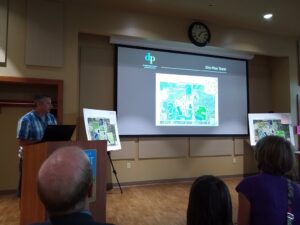
A special committee was created to draw several complete development concept plans reflecting ideas from other committees.
Whether you’re reinvigorating your downtown’s vitality, seeking great ideas for a major redevelopment project, or establishing a common vision for your municipality’s long-term future, all require one essential ingredient – your community’s involvement..
Why not put your citizens to work and give them a real ‘roll up your sleeves’ opportunity to create a collective vision for the community.
Can this process make municipal staff uneasy? Sometimes at first, but take a moment and click on the article links to see how committed your community can be when they are empowered to create the future.
If your municipality is seeking a “different” way to get your community involved, consider stepping aside and letting your community lead the process.
It’s a lot easier than you think, and so much more liberating and rewarding than you can imagine.
So, before you embark on your next important project make sure your efforts are positioned for success by revitalizing your community engagement method first.
“I found your approach to be right on track with what everyone always talks about doing, but rarely ever actually does.” – APA conference presentation attendee
All images are courtesy of Todd Streeter and Jean Werbie-Harris .
About the Author:
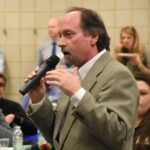 Todd Streeter is a Principle at Community Collaboration. He’s an engagement expert helping municipalities improve civic/community relationships for more than 20 years.
Todd Streeter is a Principle at Community Collaboration. He’s an engagement expert helping municipalities improve civic/community relationships for more than 20 years.
As a former mayor, chamber executive and community foundation co-founder, Community Collaboration’s award winning Working Committee™ engagement process has reshaped civic engagement and empowered community ownership.
He can be reached by phone at 651.325.7642, or by email at Todd@InvolvementisGood.com. Community Collaboration’s website is Involvementisgood.com.

